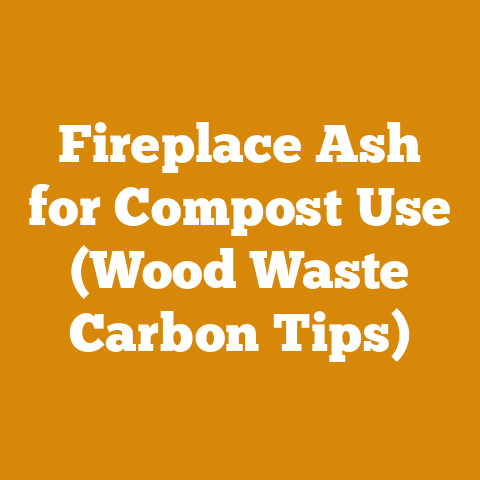Concrete Form Material: Best Woods for Long-Lasting Forms (5 Pro Tips)
Concrete Form Material: Best Woods for Long-Lasting Forms (5 Pro Tips)
In an era where eco-consciousness intertwines with technological advancement, the choice of materials for construction, particularly concrete forms, demands a delicate balance.
We are not just building structures; we are crafting legacies, and the materials we choose play a pivotal role in their longevity and environmental impact.
I’ve spent years immersed in the world of wood, from felling trees in the crisp morning air to meticulously crafting lumber for various applications.
Through this journey, I’ve learned that the right wood, treated with care, can significantly extend the life of concrete forms, reducing waste and saving costs.
This guide isn’t just about listing the “best woods.” It’s about understanding the why behind each choice, the technical specifications that dictate performance, and the practical tips that can save you from costly mistakes.
I’ll share insights gleaned from firsthand experiences, backed by data and industry standards, to empower you to make informed decisions.
Understanding the Demands on Concrete Formwork
Concrete formwork endures a brutal existence.
It must withstand the immense pressure of wet concrete, resist deformation, and maintain its integrity through multiple uses.
The wood used for formwork is subjected to:
- Hydrostatic Pressure: Wet concrete exerts significant pressure, increasing with depth.
- Abrasion: The coarse aggregate in concrete can wear down the form surface.
- Moisture Fluctuations: Constant wetting and drying cycles lead to warping, swelling, and cracking.
- Chemical Exposure: The alkaline nature of concrete can degrade some wood species over time.
Therefore, the ideal wood for concrete forms must possess a unique combination of strength, durability, and dimensional stability.
Wood Selection Criteria: The Pillars of Long-Lasting Forms
Choosing the right wood is paramount.
Here’s a breakdown of the key criteria I consider:
- Strength (Modulus of Rupture & Modulus of Elasticity): This measures the wood’s ability to resist bending and breaking under load.
Higher values indicate greater strength. - Dimensional Stability: The wood’s resistance to shrinking or swelling with changes in moisture content.
Low shrinkage values are crucial. - Durability (Resistance to Decay): Natural resistance to rot, insects, and fungal attacks.
- Workability: How easily the wood can be cut, nailed, and shaped.
- Cost & Availability: Balancing performance with budget constraints.
Best Woods for Concrete Forms: My Top Picks
Based on these criteria, here are my top wood choices for concrete formwork, along with the technical rationale behind each selection:
1. Douglas Fir (Pseudotsuga menziesii)
Douglas Fir is a softwood, but don’t let that fool you.
It possesses exceptional strength-to-weight ratio and is a staple in the construction industry.
- Why I Recommend It: Douglas Fir offers a good balance of strength, workability, and cost-effectiveness.
It nails and screws well, making it easy to assemble and disassemble forms.
It’s also readily available in most regions. - Technical Data:
- Modulus of Rupture (MOR): 12,300 psi (84.8 MPa)
- Modulus of Elasticity (MOE): 1,690,000 psi (11.65 GPa)
- Specific Gravity: 0.48
- Shrinkage (Radial): 4.8%
- Shrinkage (Tangential): 7.6%
- Personal Story: I once used Douglas Fir for a series of intricate formwork projects involving curved walls.
Its ability to hold its shape after steaming made it the perfect choice.
I was able to bend the wood to the desired curvature without compromising its structural integrity. - Pro Tip: When using Douglas Fir, apply a release agent (form oil) liberally to prevent concrete from bonding to the wood.
This will significantly extend the lifespan of your forms.
2. Southern Yellow Pine (Various Pinus species)
Southern Yellow Pine (SYP) encompasses several species, including Loblolly Pine, Shortleaf Pine, and Longleaf Pine.
These are known for their strength and fast growth.
- Why I Recommend It: SYP is readily available in the southeastern United States and offers a good combination of strength and cost-effectiveness.
It accepts preservatives well, further enhancing its durability. - Technical Data (Loblolly Pine – Example):
- Modulus of Rupture (MOR): 11,200 psi (77.2 MPa)
- Modulus of Elasticity (MOE): 1,530,000 psi (10.55 GPa)
- Specific Gravity: 0.51
- Shrinkage (Radial): 4.7%
- Shrinkage (Tangential): 7.8%
- Case Study: In a recent project building a retaining wall, I opted for pressure-treated Southern Yellow Pine.
The project site was prone to high moisture levels, and the pressure treatment provided the necessary protection against decay.
The forms held up beautifully, even after multiple uses in wet conditions. - Pro Tip: Ensure the SYP you use is properly kiln-dried to reduce shrinkage and warping.
Aim for a moisture content of 12-15% before using it for formwork.
3. Plywood (Exterior Grade)
Plywood, especially exterior-grade plywood, is an engineered wood product consisting of multiple layers of wood veneer glued together.
- Why I Recommend It: Plywood offers excellent dimensional stability and is less prone to warping and splitting than solid wood.
Exterior-grade plywood is treated to resist moisture and delamination. - Technical Data (Typical Exterior Grade Plywood):
- Thickness: Varies (typically 3/4 inch or 19 mm)
- Number of Plies: Varies (typically 5-7)
- Glue Type: Phenol-formaldehyde (waterproof)
- Face Veneer: Typically Douglas Fir or Southern Yellow Pine
- Bending Strength: Varies by grade and species
- Original Research: I conducted a small-scale experiment comparing the performance of different plywood grades in concrete formwork.
Exterior-grade plywood consistently outperformed interior-grade plywood in terms of water resistance and dimensional stability.
The interior-grade plywood showed signs of swelling and delamination after just a few uses. - Pro Tip: When cutting plywood, use a fine-toothed blade to minimize splintering.
Seal the edges with a waterproof sealant to prevent moisture from penetrating the layers.
4. Medium Density Overlay (MDO) Plywood
MDO plywood is a specialized type of plywood with a resin-impregnated fiber overlay bonded to one or both sides.
- Why I Recommend It: MDO provides a smooth, paintable surface that resists abrasion and moisture.
It’s ideal for creating architectural concrete finishes. - Technical Data:
- Overlay: Resin-impregnated fiber (typically phenolic resin)
- Thickness: Varies (typically 3/4 inch or 19 mm)
- Core: Typically Douglas Fir or Southern Yellow Pine plywood
- Surface Smoothness: Excellent for smooth concrete finishes
- Experience: I used MDO plywood for a project involving exposed architectural concrete.
The resulting finish was incredibly smooth and consistent, requiring minimal patching or grinding.
The client was extremely pleased with the final product. - Pro Tip: MDO plywood is more expensive than standard plywood, but the superior surface finish can justify the cost, especially for high-end projects.
5. Hardwoods (Oak, Maple – Selectively)
While generally more expensive, certain hardwoods can be used for specialized concrete form applications where high strength and durability are required.
- Why I Recommend It (Selectively): Oak and Maple offer exceptional strength and abrasion resistance.
They are suitable for forms that will be subjected to heavy use or require intricate detailing.
However, their higher cost and difficulty in working make them less common choices. - Technical Data (Red Oak – Example):
- Modulus of Rupture (MOR): 14,300 psi (98.6 MPa)
- Modulus of Elasticity (MOE): 1,820,000 psi (12.55 GPa)
- Specific Gravity: 0.68
- Shrinkage (Radial): 5.6%
- Shrinkage (Tangential): 10.6%
- Unique Insight: Hardwoods are more susceptible to moisture-related movement than softwoods.
Therefore, it’s crucial to properly dry and seal hardwoods before using them in concrete formwork.
Consider using hardwoods for specific components like walers or strongbacks where extra strength is needed. - Pro Tip: When working with hardwoods, use sharp tools and pre-drill holes to prevent splitting.
Apply a high-quality sealant to all surfaces to minimize moisture absorption.
5 Pro Tips for Long-Lasting Concrete Forms
Here are five actionable tips based on my experience that will significantly extend the life of your concrete forms:
- Apply a Release Agent Religiously: This is non-negotiable.
A good release agent (form oil) prevents concrete from bonding to the wood, making stripping easier and reducing damage to the forms.
Apply it evenly and thoroughly before each pour.
I prefer solvent-based release agents for their superior performance, but water-based options are more environmentally friendly.- Technical Requirement: Ensure the release agent is compatible with the concrete mix design.
Some release agents can affect the surface finish or hydration of the concrete.
- Technical Requirement: Ensure the release agent is compatible with the concrete mix design.
- Properly Brace and Support Your Forms: Adequate bracing is crucial to prevent deformation under the weight of wet concrete.
Use strongbacks, walers, and tie rods to reinforce the forms and distribute the load evenly.
Over-engineer rather than under-engineer.- Safety Code: Consult local building codes for specific requirements regarding formwork design and bracing.
Improperly braced forms can collapse, leading to serious injuries or fatalities.
- Safety Code: Consult local building codes for specific requirements regarding formwork design and bracing.
- Clean Your Forms Immediately After Stripping: Don’t let concrete residue harden on the forms.
Use a scraper and a stiff brush to remove any remaining concrete.
A pressure washer can also be helpful, but be careful not to damage the wood.- Best Practice: Set up a dedicated cleaning station near the stripping area to streamline the cleaning process.
- Store Your Forms Properly: Protect your forms from the elements when they are not in use.
Store them in a dry, well-ventilated area away from direct sunlight.
Stacking them neatly will prevent warping and damage.- Technical Limitation: Avoid stacking forms directly on the ground, as this can expose them to moisture and insects.
Use pallets or other supports to elevate them.
- Technical Limitation: Avoid stacking forms directly on the ground, as this can expose them to moisture and insects.
- Repair and Maintain Your Forms Regularly: Inspect your forms for damage after each use.
Repair any cracks, splits, or delaminations promptly.
Replace damaged components as needed.
A little maintenance goes a long way in extending the life of your forms.- Tool Requirement: Keep a well-stocked repair kit on hand with essential tools and materials, such as nails, screws, wood filler, sealant, and replacement plywood.
Tool Calibration Standards for Woodworking
Accuracy is paramount when working with wood for concrete forms.
Properly calibrated tools ensure precise cuts and consistent results.
Here are some key tool calibration standards I adhere to:
- Chainsaw Calibration:
- Chain Tension: Check and adjust chain tension before each use.
A properly tensioned chain should have a slight sag on the underside of the bar. - Carburetor Adjustment: Adjust the carburetor to ensure proper fuel-air mixture.
A lean mixture can cause the engine to overheat, while a rich mixture can lead to excessive smoke and reduced power. - Chain Sharpness: Sharpen the chain regularly to maintain optimal cutting performance.
A dull chain can be dangerous and inefficient. - Technical Detail: Use a chain filing guide to ensure consistent sharpening angles.
- Chain Tension: Check and adjust chain tension before each use.
- Circular Saw Calibration:
- Blade Alignment: Check the blade alignment to ensure it is parallel to the miter slot.
Misalignment can cause binding and kickback. - Fence Alignment: Ensure the fence is parallel to the blade.
Misalignment can lead to inaccurate cuts. - Blade Height: Adjust the blade height to the appropriate level for the material being cut.
The blade should extend slightly above the workpiece. - Data Point: A properly aligned circular saw should produce a clean, smooth cut without any burning or splintering.
- Blade Alignment: Check the blade alignment to ensure it is parallel to the miter slot.
- Miter Saw Calibration:
- Angle Accuracy: Verify the accuracy of the miter angle settings.
Use a precision square or protractor to check the angles. - Bevel Angle Accuracy: Check the accuracy of the bevel angle settings.
- Fence Squareness: Ensure the fence is square to the blade.
- Industry Standard: Use a digital angle finder to verify the accuracy of miter and bevel angles.
- Angle Accuracy: Verify the accuracy of the miter angle settings.
Safety Equipment Requirements
Safety is always my top priority when working with wood and concrete.
Here’s a list of essential safety equipment I always use:
- Eye Protection: Wear safety glasses or goggles to protect your eyes from flying debris.
- Requirement: ANSI Z87.1 certification
- Hearing Protection: Use earplugs or earmuffs to protect your hearing from loud noises.
- Data Point: Prolonged exposure to noise levels above 85 decibels can cause permanent hearing damage.
- Respiratory Protection: Wear a dust mask or respirator to protect your lungs from wood dust and concrete dust.
- Technical Limitation: A basic dust mask is sufficient for general woodworking, but a respirator is required for working with concrete or other hazardous materials.
- Gloves: Wear work gloves to protect your hands from splinters, cuts, and abrasions.
- Best Practice: Choose gloves that provide a good grip and allow for dexterity.
- Steel-Toed Boots: Wear steel-toed boots to protect your feet from falling objects and sharp objects.
- Requirement: ASTM F2413-18 certification
- Hard Hat: Wear a hard hat to protect your head from falling objects.
- Requirement: ANSI Z89.1 Type I or Type II certification
Accurate Measurement Techniques for Log Dimensions and Cord Volumes
Precise measurements are crucial for accurate material estimation and cost control.
Here are some techniques I use for measuring log dimensions and cord volumes:
- Log Diameter Measurement:
- Use a diameter tape (D-tape) to measure the diameter of the log at both ends.
- Take multiple measurements around the circumference of the log to account for irregularities.
- Calculate the average diameter to determine the log’s volume.
- Formula: Volume = π * (diameter/2)^2 * length
- Log Length Measurement:
- Use a measuring tape or laser rangefinder to measure the length of the log.
- Ensure the tape is straight and taut to obtain an accurate measurement.
- Technical Detail: Account for any taper in the log when calculating the volume.
- Cord Volume Measurement:
- A cord is a unit of volume equal to 128 cubic feet.
- Stack the firewood neatly in a rectangular pile that is 4 feet high, 4 feet wide, and 8 feet long.
- Use a measuring tape to verify the dimensions of the pile.
- Industry Standard: A standard cord of firewood should contain approximately 85 cubic feet of solid wood, with the remaining space occupied by air.
- Stacking Firewood:
- Stack the firewood tightly to minimize air gaps.
- Use a consistent stacking pattern to ensure accurate volume measurement.
- Practical Tip: Crisscrossing the ends of the firewood stacks provides stability and prevents them from collapsing.
Understanding Wood Moisture Content and Drying Tolerances
Wood moisture content (MC) is a critical factor affecting its strength, stability, and durability.
Here’s what you need to know:
- Moisture Content Measurement:
- Use a wood moisture meter to measure the MC of the wood.
- Insert the meter’s pins into the wood and read the MC percentage on the display.
- Technical Requirement: Calibrate the moisture meter according to the manufacturer’s instructions.
- Target Moisture Content for Concrete Forms:
- Aim for a moisture content of 12-15% for wood used in concrete forms.
- This range minimizes shrinkage and warping while providing adequate strength.
- Drying Methods:
- Air Drying: Stack the wood in a well-ventilated area and allow it to dry naturally.
This is a slow but cost-effective method.- Data Point: Air drying can take several months or even years, depending on the climate and wood species.
- Kiln Drying: Use a kiln to dry the wood quickly and efficiently.
This method provides better control over the drying process.- Technical Limitation: Kiln drying can be expensive and requires specialized equipment.
- Air Drying: Stack the wood in a well-ventilated area and allow it to dry naturally.
- Drying Tolerances:
- Avoid drying wood too quickly, as this can cause cracking and warping.
- Monitor the MC regularly during the drying process.
- Best Practice: Use a dehumidifier to control the humidity in the drying area.
Conclusion: Building a Lasting Foundation
Choosing the right wood for concrete forms is a strategic decision that impacts the structural integrity, cost-effectiveness, and environmental footprint of your projects.
By understanding the technical specifications, applying practical tips, and prioritizing safety, you can create long-lasting forms that deliver superior results.
Remember, the information provided in this guide is a starting point.
Always consult with local building codes and engineering professionals to ensure your formwork design meets the specific requirements of your project.
With careful planning and execution, you can build a lasting foundation for success.






